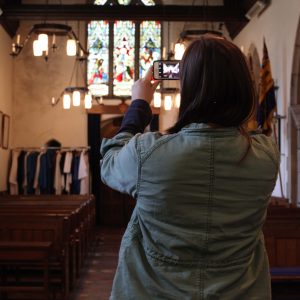Call for volunteers to survey the nation’s churches for bats this summer!

It is thought that at least 60 percent of pre-16th century churches across the country contain bat roosts, but this is an out of date estimate, it could be many more and it’s likely to vary widely across the country.
For centuries, bats have been associated with churches and in some cases these historic buildings are home to national and even internationally important bat roosts.
The Bats in Churches Study aims to understand how and why these protected mammals use church buildings and is appealing for volunteers to come forward to help by searching for evidence of bats in their local church. The surveys run from the beginning of June to the end of August and are covid secure with guidelines provided for participants upon registration.
The study has already thrown up some surprising results, in its trial year, volunteers were delighted to discover the presence of grey long-eared bats in a Devon church. These are one of the rarest mammals in Britain, with an approximate population of 1000, there are few known records of this species using churches.
Of the 115 churches that have been surveyed for the study so far by our volunteers, nearly 70 percent have shown evidence of bats, but it's still very early to draw any conclusions, which is why we need lots more volunteers to reach our target of 500 churches.
The study is led by us, Bats in Churches, a five-year project funded by the National Lottery Heritage Fund and bringing together partners from the conservation and heritage sectors to reduce the damage that bats can cause in churches while also protecting their roosts.
The project is helping to provide innovative solutions that allow bats and churches to occupy the same space without conflict and works closely with ecologists, church architects and communities.
You can find out more about what the survey entails and how to sign up here. Participants are encouraged to share their experiences on social media using #ChurchBatDetective.
We're very much looking forward to this year's discoveries!
Adrian Bayley, Volunteer Surveyor for the Bats in Churches Study who discovered the rare bat said:
"I enjoyed taking part in the Bats in Churches Study. I was pleased that some of the droppings collected proved to be those of a Grey long-eared bat! I am looking forward to surveying more churches this summer.”
Claire Boothby, Training and Survey Officer, Bats in Churches Project said:
“We know churches are important for bats, but we are still in the dark about how many of the 16,000 Church of England churches are used by these protected mammals. We want to understand the factors affecting bats use of churches and also get a better picture of the impacts (both positive and negative) on those caring for these buildings. By helping unveil the mystery, by looking for evidence of bats and speaking to a representative of the church this summer, you’ll help us to provide better advice and guidance for both church and bat conservation.”
Environmental Ecologist Phillip Parker of Phillip Parker Associates said:
“Out of the nearly 270 historic churches that I’ve surveyed in Norfolk, only 4 didn’t show evidence of bats, which is significantly higher than the current national estimate, but anecdotal information like this is patchy and isn’t available for most counties which is why this study is so important. It will be very interesting to gain a better picture of bats’ use of churches across the country so that we can understand the importance of individual roosts and tailor our approach towards conservation in those areas to benefit both bats and churches.”
